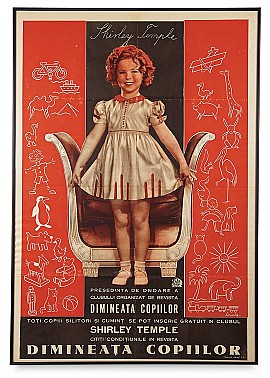Unique Ephemera Related to Shirley Temple's Fundraising for the Motion Picture Relief Fund
Lot #416
Comprising a folio with blue leather exterior that is gilt-lettered Shirley Temple, and silk lined with a parchment testimonial thanking Shirley Temple for her "unselfish service" at the December 24, 1939 broadcast. Along with a record album lettered "Thank You, Shirley Temple" for the December 24, 1939 Christmas Eve premiere of "The Screen Guild Show", starring Shirley Temple, Nelson Eddy and the St. Brendan's Boys Choir, comprising three two-sided records, recorded by Radio Recorders of Hollywood, and with record labels bearing the mark of the Motion Picture Relief Fund, Inc. Radio with a sketch of the proposed Rest Home for the Picture Industry. Also included are three "electrical transcriptions" of the same performance from the Los Angeles Recording Studio, each hand-lettered with "Shirley's First Broadcast". And with three "Thank You Shirley Temple" albums of subsequent benefit performances for the Motion Picture Relief Fund: "First Love" on May 14, 1945 along with Peter Lawford and Arthur Treacher; "Adorable" on October 26, 1946 with Peter Lawford and Charles Coburn; and "The Bachelor and the Bobby Soxer" on May 10, 1946 with Cary Grant and Myrna Loy". From the early days of Hollywood film, the need became evident to aid those of the film world who had fallen on hard times. Early efforts included coin box drops, payroll pledges, and celebrity benefit events. Then, in 1939 Jean Hersholt (known to Shirley Temple fans as Grandfather in "Heidi") spearheaded a new program. It was to be a radio show, "The Screen Guild Stars", which premiered on over 61 CBS stations in 1939. The stars were top names in Hollywood, commanding premium salaries, yet for this program they donated all of their earnings to the Motion Picture Relief Fund. Among the stars who donated many hours to this cause was Shirley Temple, and in 1946, she extended her support for the Motion Picture and Television Country House and Hospital. Throughout her life, Shirley Temple recognized that although, in fact, she was one of the privileged of the world, it remained her duty to aid the less fortunate. This vision served her throughout her life, in all of her humanitarian causes, from local charitable missions to her international assignments. In all, she remained ardent yet humble, a veritable symbol of a life well-lived.






























































































































































































































































































































































































































